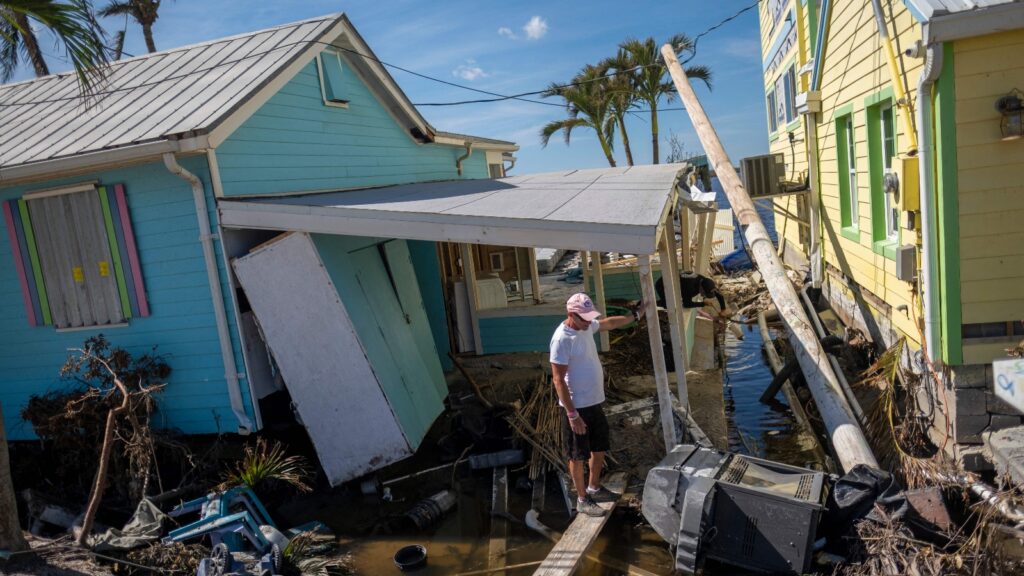Hurricane Season Could Result In Higher Homeowners Insurance Rates – InsuranceNewsNet
An air of uncertainty is brought onto Florida residents every year between the months of June and November. While meteorologists’ predictions may attempt to guess how many named storms may wash over the state, and how strong each may be, nothing is ever certain.
This hurricane season, homeowners are dealing with an added layer of unpredictability — the ability to insure their properties, let alone volatility in premiums and deductibles. Plus, monthly electric bills could bump up next year to pay for storm hardening projects.
Some insurers are dropping clients, others are no longer writing policies in the state, while those keeping customers may in some cases double policy renewal rates. In the worst case, they’ve gone belly-up altogether.
It’s an issue that has been bubbling for the past year and a half. Mostly to blame, industry experts say, is the vast amount of litigation against insurance companies fueled by so-called free roof-replacement schemes.
That trend has left thousands of homeowners automatically in the hands of another insurance provider, left to wade the waters of the dwindling private market to find new coverage or end up at the doorstep of Citizens Property Insurance Corporation, the state-backed, longtime insurer of last resort.
“We’re in a very precarious position right now,” said Mark Friedlander, corporate communications director with the Insurance Information Institute. “We’re continuing to see deteriorating conditions for many insurers. It’s not a good situation for homeowners and certainly not a good situation for insurers as well.”
So far this year, three property insurance companies serving Florida homeowners have gone into receivership, with a fourth, FedNat Insurance Group, having its financial stability rating downgraded in April, the first sign of an insurer in trouble.
One of the top 10 largest home insurers in Florida with 152,000 policyholders, FedNat and its related companies must now cancel 68,200 policies in a plan approved by the state insurance regulator. Demotech, the rating company, said more insurers are being watched closely.
Few insurers forcing homeowners to use ‘surplus line’ insurers
Fewer insurers on the private market are leading homeowners to “surplus lines” insurers or state-supported Citizens. A surplus line insurer isn’t regulated by the state and therefore doesn’t have the cushion of the Florida Insurance Guaranty Association, which was created by the legislature to pay claims from insolvent insurers. Should the surplus line insurer go into receivership before claims are paid out, the homeowner won’t get paid.
Citizens is on track to have more than 1 million policies on its books by the end of the year, which hasn’t been seen since 2013. Around 400,000 policies is Citizens’ sweet spot, said spokesperson Michael Peltier, but the insurer has more than doubled that number — and growing. Last year, Citizens was gaining between 3,500 and 4,500 policies a week; now the average is 6,500 policies a week.
The state-run insurer has a healthy $6.5 billion surplus, Peltier said. But as it gains and holds more and more policies because of the volatile marketplace, the risk grows where a one-in-100-year storm could wipe out that cushion.
If that happens and money from Citizens runs out to pay claims, all property insurance holders will be charged.
“We don’t want to be in that position,” Peltier said. “The best thing to do is have a healthy private insurance market.”
Special session is called to address property insurance market issues
Lawmakers will be headed back to Tallahassee for a second special session this month, set to end just as hurricane season begins, to address problems with the property insurance market that they failed to attempt during the regular session.
Whatever lawmakers do decide, if anything, won’t be a silver bullet fix, Friedlander said.
“The issues we’re facing today will not disappear. If they pass meaningful legislation, your bill is not going to decrease soon,” he said.
State Sen. Jeff Brandes, the St. Petersburg Republican who led the call for a special session on insurance reform, said a direct storm hit in Florida would lead to more damage, more claims and therefore an “absolute spike in litigation.”
“While I believe a storm wouldn’t be a problem for most insurance companies, multiple storms would be devastating,” he said.
One of the solutions Brandes said he would like to see proposed during the five-day session includes reducing rates paid by insurers into the Florida Hurricane Catastrophe Fund, which he said would result in $1 billion in savings for consumers.
The purpose of the fund, created after Hurricane Andrew 30 years ago this August, is to reimburse insurers for part of their hurricane-related losses and serves as a state-run reinsurance option, essentially back-up capital, that may be a less expensive option for insurers, meaning fewer costs passed onto customers.
“That’s just a tourniquet. That’s just a triage and keeps them alive for a few months,” Brandes said.
Other issues that he said should be addressed include allowing more flexibility in the types of insurance policies offered and tweaking the building code as it relates to roof repairs.
“This is the worst property insurance market in Florida’s history,” Brandes said. “People need to know how damaging it will be if the Legislature does not resolve these issues.”
As hurricane season nears, now’s the time to do an ‘insurance checkup’
State Sen. Annette Taddeo, a Democrat from Miami who is running for governor, wasn’t confident in the outcome of this month’s special session.
“I think it’s going to be window dressing for election purposes, and it’s not really going to bring down (the cost of) people’s policies,” she said.
Taddeo hoped any proposal seeking savings for consumers must make sure those savings are actually passed onto consumers.
“Instead what ends up happening is the bills continue to go up and they cover less,” she said.
Taddeo acknowledged that a number of factors are affecting the property insurance market, but if one key issue was fraudulent roofing schemes, that should be addressed with full force.
“We don’t pass laws to say that you will not only have to pay this much, but you will lose your license and you won’t be able to open another business in another name here,” she said. “That’s what we should be doing, so that then you’re able to reduce the wrongdoing.”
Ahead of the start of hurricane season, homeowners should do an “insurance checkup” with their agent and take stock of their coverage to ensure that it’s adequate enough to cover the inflated cost of repairs and labor, Friedlander said.
Other tips include keeping important documents in one, easy-to-access place; taking photo and video inventory of your property; trimming vegetation away from your house; and coming up with an emergency plan with the people who live there.
FPL storm-hardening could trickle down into customer’s bills
Property insurance isn’t the only storm-adjacent cost increase that residents seem to face every year.
Florida Power & Light customers could see a slight bump in their monthly bills to pay for the utility’s ongoing, annual storm-hardening projects.
Currently, a FPL customer who uses 1,000 kilowatts hours of energy each month pays $2.14 in their bill for the utility’s storm protection plan that fortifies the grid. This year, FPL wants to charge an extra $1.70 a month, or an additional $20.40 a year.
This increase will cover the expected $4.7 million that FPL says it will have undercharged customers for this year’s storm-protection plan.
The fee goes toward projects such as inspecting 1.4 million distribution poles; replacing wooden transmission poles with concrete ones; raising equipment at substations to protect against storm surge; and managing vegetation around the utility’s equipment.
These kinds of non-descript upgrades appear to hide in plain sight, save for a minor traffic interruption as the work is done. On a recent morning in Jupiter, crews worked on replacing a wooden feeder pole with a concrete one along Roebuck Road. A truck with a mounted crane carefully lifted the concrete pole up and over energized lines carrying 13,000 volts, and settled it next to the old pole.
A project like this may not appear like much of an improvement, but it could mean the difference between having an outage for a few hours versus a few days.
“I have a lot of friends and family who live in the area, and when they see this kind of investment, they really recognize, ‘Wow, I see my bill at work,'” said Wally Woodard, operations manager with FPL. “To share this with 5 million customers, it’s not a huge impact to each individual.”
Following the disastrous hurricane seasons in 2004 and 2005, utilities have been required by the regulators at the Florida Public Service Commission to boost resiliency and the ability to recover quicker from future storms.
In a filing with the PSC, FPL compared the speed at which it was able to restore power between Wilma in 2005 and Irma in 2017. Wilma had 3.2 million outages and took an average of 5.4 days to restore power, whereas Irma left 4.4 million without power and took an average of 2.1 days to restore power.
The costs for these projects were folded into the utility’s base rate, which is decided every three to five years. But in 2019, lawmakers approved a carveout charge just for storm-hardening projects, for which utilities can request fee changes at the PSC each year. Utilities are also required to submit a 10-year outlook every three years.
The Juno Beach-based utility said it plans to spend nearly $14.9 billion through 2032 on these projects, according to FPL’s 10-year storm protection plan submitted last month.
FPL also proposing project to prepare for extreme winter weather
It will continue storm management projects already in place while proposing two additional kinds of projects: “winterization” of its power plants, as part of its effort to prepare for extreme winter weather and improving access to transmission facilities by building roads, bridges and culverts at these sites.
Motivated by last year’s deadly Texas storm, FPL’s winterization plan will include replacing equipment to better handle high electricity loads.
Those projects are likely to happen between 2023 and 2026 and cost more than $150 million, according to the utility’s proposal. Projects addressing transmission facility access are expected to cost $117 million.
If the PSC approves this request, the new charges would go into effect next year.
Hannah Morse covers consumer issues for The Palm Beach Post. Drop a line at [email protected], call 561-820-4833 or follow her on Twitter @mannahhorse.
Some insurers are dropping clients, others are no longer writing policies in
the state, while those keeping customers may in some cases double policy renewal rates. In the worst case, they’ve gone belly-up altogether.
This content was originally published here.




Responses